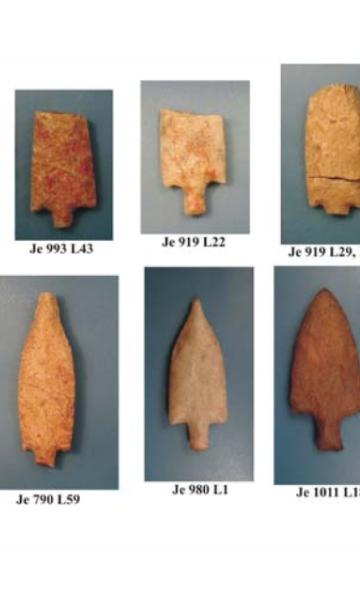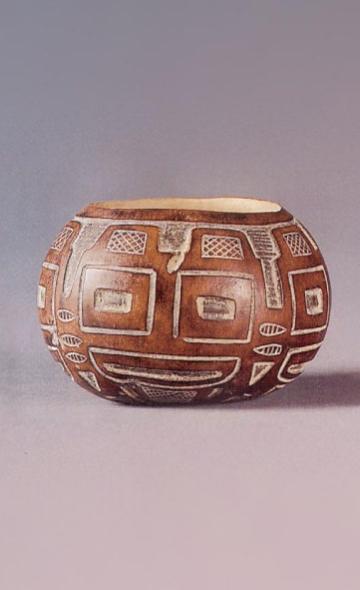- Visitors
- Researchers
- Students
- Community
- Information for the tourist
- Hours and fees
- How to get?
- Virtual tours
- Classic route
- Mystical route
- Specialized route
- Site museum
- Know the town
- Cultural Spaces
- Cao Museum
- Huaca Cao Viejo
- Huaca Prieta
- Huaca Cortada
- Ceremonial Well
- Walls
- Play at home
- Puzzle
- Trivia
- Memorize
- Crosswords
- Alphabet soup
- Crafts
- Pac-Man Moche
- Workshops and Inventory
- Micro-workshops
- Collections inventory
- News
- Researchers
- The first inhabitants of the Chicama Valley. Evidence from Huaca Prieta and Pampas de Paiján
News
CategoriesSelect the category you want to see:

International academic cooperation between the Wiese Foundation and Universidad Federal de Mato Grosso do Sul ...

Clothing at El Brujo: footwear ...
To receive new news.
Por: Augusto Bazán Pérez
Augusto Bazán Pérez
Wiese Foundation | El Brujo Archaeological Complex
Director of Investigation
Introduction
The first evidence of human occupation in the Chicama Valley dates to around 14,000 years ago. These early occupations occurred during a period that Archaeologists refer to as the “Lithic Period” (15,000-7,600 BCE) (Kaulicke 1994; Lumbreras 1969), which is characterized by social groups that gathered plants from nature and hunted wild animals to survive. It took place from the beginning of the population of the continent until the start of the domestication of plants and animals. Human beings lived in caves or campsites, as nomads without permanent residences, hunting and gathering what nature provided. Without having pottery, metallurgy, or agriculture yet, their tools were mainly made of wood, bone, and stone, used to cut, carve, and crush. The preservation up to the present of inorganic material (stone) is the reason behind the period’s name. The environment during that period was very different from the one we live in today.
Evidence from Huaca Prieta
The oldest evidence of human occupation in the Central Andes is from the Chicama Valley, specifically Huaca Prieta, located at the southern end of the El Brujo Archaeological Complex. Thousands of years before the construction of the ashy mound that Junius Bird would investigate during the 1940s, the first human beings occupied this space to make seasonal camps that allowed them to collect and hunt food provided by ecosystems now extinct, between 14,000 and 10,000 years before the present (Dillehay 2017; Dillehay, Bonavia, S. Goodbred, et al. 2012; Dillehay, Bonavia, S. L. Goodbred, et al. 2012).
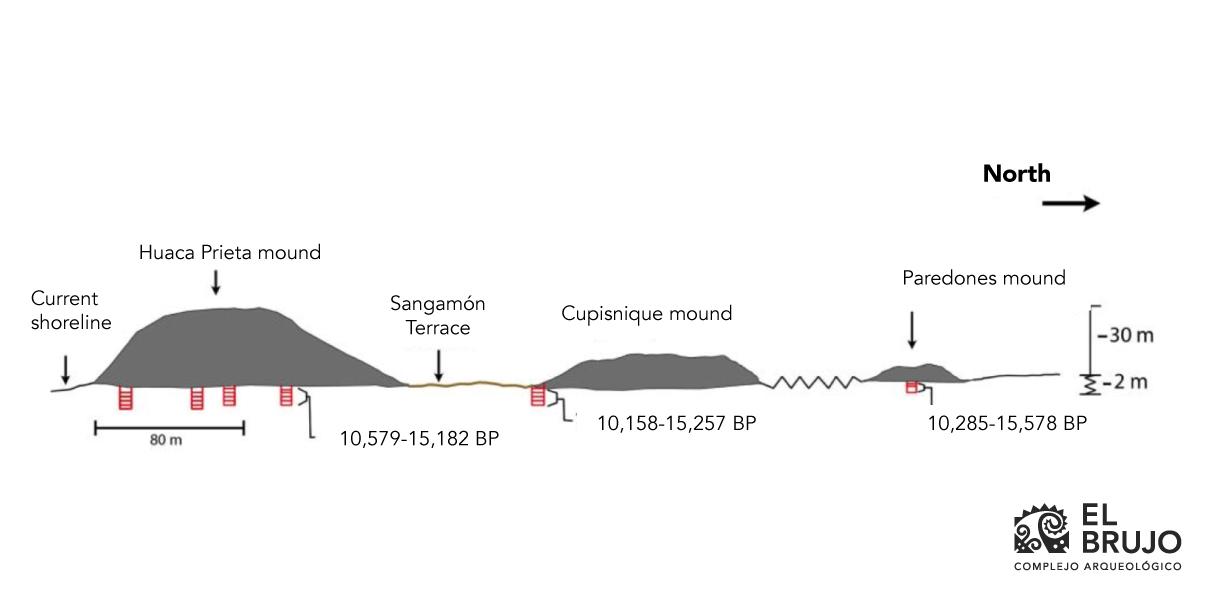 Figure 1. Diagram of the occupations during the Lithic Period at the southern end of the El Brujo Archaeological Complex (Dillehay et al. 2017: fig. S2). The drawing shows that excavations were done under the current mounds of Huaca Prieta, Cupisnique, and Paredones, identifying human occupations that date to over 10,000 years ago. “BP” means “before present”, or before the current time.
Figure 1. Diagram of the occupations during the Lithic Period at the southern end of the El Brujo Archaeological Complex (Dillehay et al. 2017: fig. S2). The drawing shows that excavations were done under the current mounds of Huaca Prieta, Cupisnique, and Paredones, identifying human occupations that date to over 10,000 years ago. “BP” means “before present”, or before the current time.
The first inhabitants of El Brujo exploited the habitats of their immediate surroundings, since the sea was many kilometers away, and between them and the sea there were a great variety of lakes, wetlands, and lagoons that drained into the ocean. The resources procured from these ecosystems wre carried to the pre-mound camps at El Brujo for processing and consumption.
Recently, researchers have identified the consumption of 281 specimens of marine fauna, and only three specimens from the inland valley, which shows their high dependence on their immediate environment1. The presence of stone weights used in reed tramps has also been recorded, an activity that is practiced to this day to catch fish that are washed to shore by the sea’s waves. The tools that were used were rather basic: early unifacial forms, so they had not begun to work both sides of the same object, as we will see in the later Paiján style of points.
Toward the end of the Pleistocene (14,000-11,500 BP), sea level rose quickly due to the rise in global temperatures, so a large part of the ancient coast, precisely the area that the first inhabitants exploited, was flooded by seawater. Thus, the earliest archaeological sites on the Andean coast are probably submerged under the post-glacial sea.
Paiján
Paiján has been defined as a complex, culture, or tradition of hunter-gatherers, evidence of which has been found principally in the Paiján Plains, between the northern margin of the Chicama and the southern margin of the Jequetepeque Valley, at the mouth of the Cupisnique Gorge. Although the Paiján Plains are the area with the greatest density and abundance of evidence from this period, the Paiján occupation covered the coastal band from Zaña to Ica (Bonavia and Chauchat 1990) and ascended to the foothills of the mountains, in the gorges that are dry or have seasonal rivers that flow down from the Andes Mountains. The primary characteristic of this complex from the Lithic Period is the manufacture of stemmed projectile points with a very sharp point, of many different sizes (Briceño 2010; Chauchat 2012). The Paiján tradition lasted approximately from 12,400 to 9,000 BP (10,679-7,055 BCE) (Chauchat et al. 2006; León 2007).
1. They consumed sharks (27.55%), sea lions (15.85%), sea birds (13.96%), and bony saltwater fish (12.83%). Very small quantities of limpets, sea snails (gastropods), crabs, land animals, and plants were consumed, including beans (Phaseolus sp.), which suggests contact with inhabitants of the inland valley (Dillehay et al. 2017: 7).
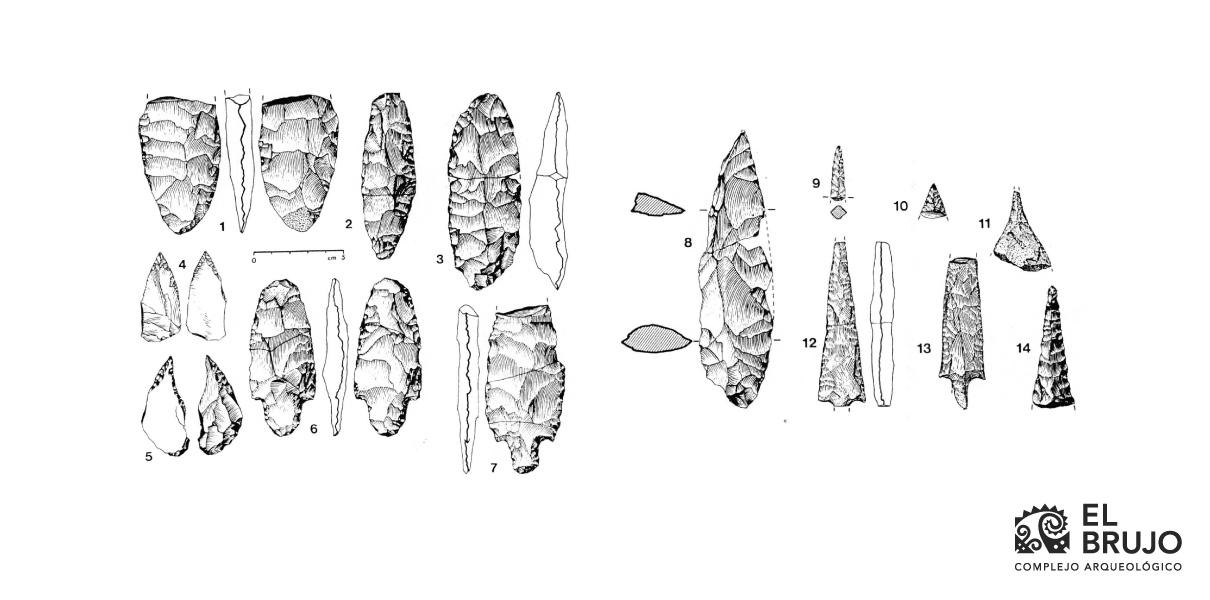
Figure 2. Projectile points of the leafy type, from the Paiján Plains, specifically from Unit 42, Fossil Plains 12. Taken from Chauchat et al. 2006: Fig. 31.
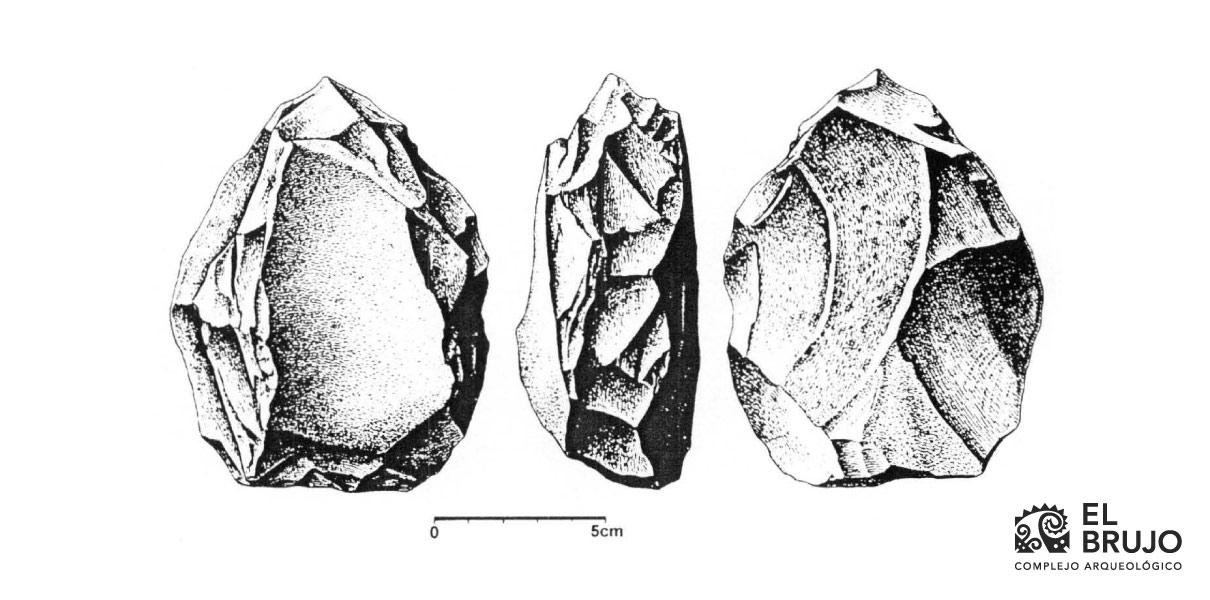 Figure 3. Example of a core (Chauchat et al. 2006: Fig. 39). From these blocks of stone, through percussion, flakes or small sharp blades were obtained to carry out different tasks related to hunting and gathering, or the processing of food obtained from these activities.
Figure 3. Example of a core (Chauchat et al. 2006: Fig. 39). From these blocks of stone, through percussion, flakes or small sharp blades were obtained to carry out different tasks related to hunting and gathering, or the processing of food obtained from these activities.
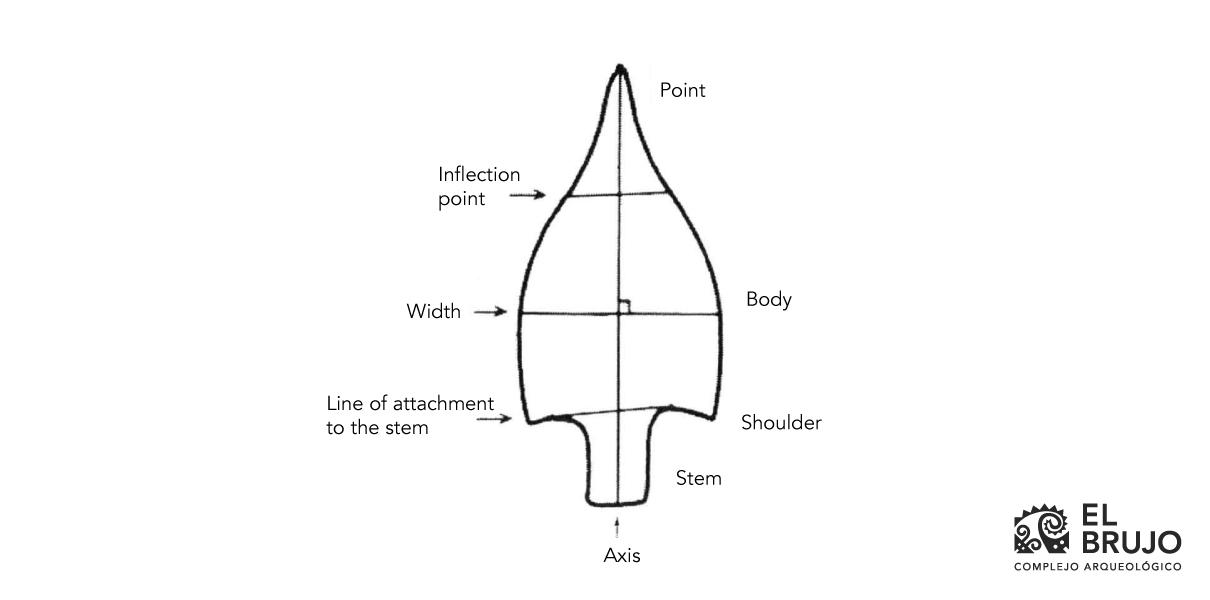 Figure 4. General form of a stemmed Paiján point and its parts (Chauchat et al. 2006: Fig. 9). This identification of the components of objects is important for the study of the style and function of material culture from the humans of this period, evidence of whom, due to time and problems with conservation, is very scarce.
Figure 4. General form of a stemmed Paiján point and its parts (Chauchat et al. 2006: Fig. 9). This identification of the components of objects is important for the study of the style and function of material culture from the humans of this period, evidence of whom, due to time and problems with conservation, is very scarce.
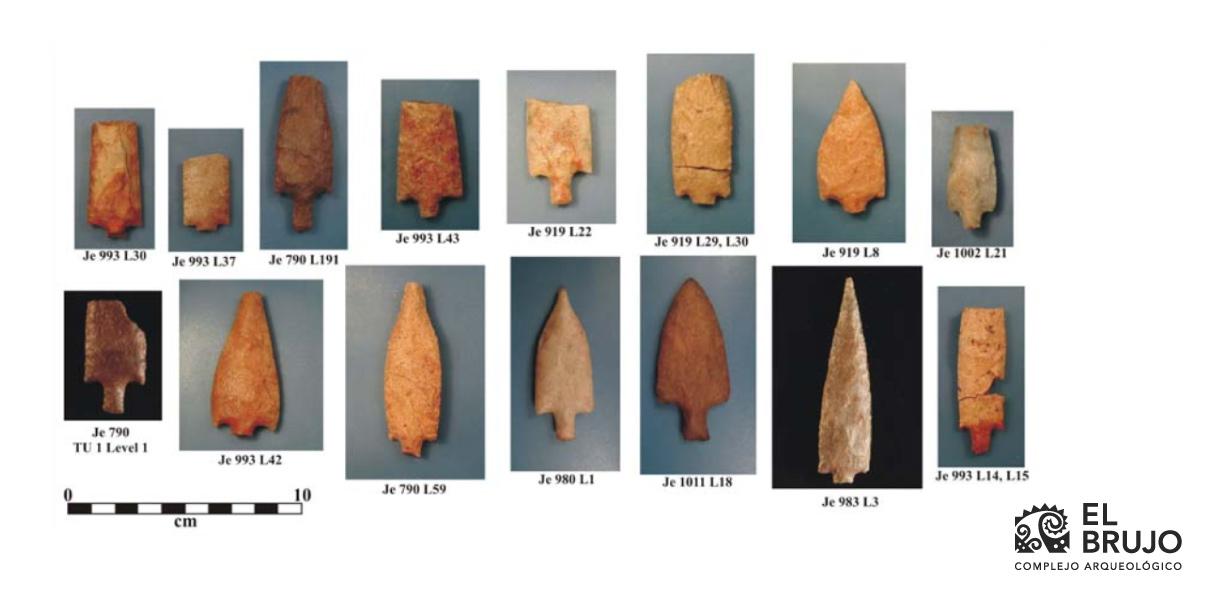 Figure 5. Examples of Classic Paiján points (Maggard 2010: Figure 8.19).
Figure 5. Examples of Classic Paiján points (Maggard 2010: Figure 8.19).
The Paiján extensively occupied the wide plains region, using primarily stone tools, but this region, which is currently a large, arid, and desertic area, at that time consisted of a much more favorable environment than the current one.
The fact that the diet of those early inhabitants was largely based on land animals2, in addition to the strong evidence for the consumption and presence of land snails, suggests that during these times, the environment was much less arid and more humid and rainier than at present (Chauchat et al. 1992; Pelegrin and Chauchat 1993). The presence of a low but significant percentage of consumption of fish and mollusks suggests that the Paiján also transited the ancient shore and/or had contact with communities related to these areas of exploitation (Sandweiss 2003).
The Paiján sites (Chauchat 2012; Chauchat et al. 1998), basically campsites, are currently located 15 km or more from the shoreline, but during the time of their use, they would have been between 20 and 100 km from the shoreline, as researchers have suggested (Chauchat et al. 2006). As with the previous case, many sites from this period, if not the majority, are today hidden by the Pacific Ocean, due to the rise in sea level at the end of the Pleistocene.
Epilogue
The first humans on the North Coast and in the Chicama were hunter-gatherers who were highly adapted to their environmental conditions and the resources that they had at their immediate disposal. The basic toolkit for obtaining subsistence resources was limited to instruments made from perishable organic material and stone. They lived in camps, moving from one place to another in search of resources, although it is not out of the question that there may have been certain groups that were more specialized in procuring products from one ecosystem in particular. It is suspected that there were groups that, while still nomads, had more experience in exploiting marine and shoreline resources and others that had more experience in exploiting the humid forests that are now dry and arid plains. These very ancient early ways of life are still difficult to understand due to their scarce remains and the remote time in which they occurred. These conditions of life, very basic and hard to read, would end when humans began to domestic plants and animals, thus depending less on what was provided strictly by nature.
74% of the diet was based on land animals (mammals [mainly white-tailed deer and rodents], reptiles, and snakes), 3% on birds, and 16% on fish.
References
Bonavia, Duccio, y Claude Chauchat. 1990. «Presencia de Paijanense en el desierto de Ica». Bulletin de l’Institut français d’études andines 19:399-412.
Briceño, Jesús. 2010. «Las Tradiciones Líticas del Pleistoceno Tardío en la Quebrada Santa María, Costa Norte del Perú. Una Contribución al Conocimiento de las Puntas de Proyectil Paleoindias Cola de Pescado». Tesis Doctoral, Freien Universität Berlin.
Chauchat, Claude. 2012. «El sitio pajanense Ascope 12 en la Quebrada de la Camotera y el grupo de Ascope, La Libertad, Perú». Ñawpa Pacha: Journal of Andean Archaeology 32(1):1-42. doi: 10.1179/naw.2012.32.1.1.
Chauchat, Claude, César Gálvez, Jesús Briceño, y Santiago Uceda. 1998. Sitios Arqueológicos de la Zona de Cupisnique y la Margen Derecha del Valle de Chicama. Lima: Instituto Nacional de Cultura La Libertad - Instituto Francés de Estudios Andinos.
Chauchat, Claude, Elizabeth Wing, Jean-Paul Lacombe, Pierre-Yves Demars, Santiago Uceda, y Carlos Deza. 2006. Prehistoria de la costa norte del Perú: el Paijanense de Cupisnique. Lima: Instituto Francés de Estudios Andinos - Patronado Huacas del Valle de Moche.
Dillehay, Tom, ed. 2017. Where the Land Meets the Sea. Fourteen Millennia of Human History at Huaca Prieta, Peru. Texas University Press.
Dillehay, Tom, Duccio Bonavia, Steve L. Goodbred, Mario Pino, Victor Vásquez, y Teresa Rosales Tham. 2012. «A late Pleistocene human presence at Huaca Prieta, Peru, and early Pacific Coastal adaptations». Quaternary Research 77(3):418-23. doi: 10.1016/j.yqres.2012.02.003.
Dillehay, Tom, Duccio Bonavia, Steven Goodbred, Mario Pino, Victor Vasquez, Teresa Rosales Tham, William Conklin, Jeff Splitstoser, Dolores Piperno, José Iriarte, Alexander Grobman, Gerson Levi-Lazzaris, Daniel Moreira, Marilaura Lopéz, Tiffiny Tung, Anne Titelbaum, John Verano, James Adovasio, Linda Scott Cummings, Phillipe Bearéz, Elise Dufour, Olivier Tombret, Michael Ramirez, Rachel Beavins, Larisa Desantis, Isabel Rey, Philip Mink, Greg Maggard, y Teresa Franco. 2012. «Chronology, mound-building and environment at Huaca Prieta, Coastal Peru, from 13 700 to 4000 years ago». Antiquity 86(331):48-70. doi: 10.1017/S0003598X00062451.
Dillehay, Tom, Steve Goodbred, Mario Pino, Víctor F. Vásquez Sánchez, Teresa Rosales Tham, James Adovasio, Michael B. Collins, Patricia J. Netherly, Christine A. Hastorf, Katherine L. Chiou, Dolores Piperno, Isabel Rey, y Nancy Velchoff. 2017. «Simple technologies and diverse food strategies of the Late Pleistocene and Early Holocene at Huaca Prieta, Coastal Peru». Science Advances 3(5). doi: 10.1126/sciadv.1602778.
Kaulicke, Peter. 1994. Los orígenes de la civilización andina. Historia General del Perú, Tomo 1. Lima: Editorial Brasa.
León, Elmo. 2007. Orígenes Humanos en los Andes del Perú. Primera Edición. Lima: Universidad de San Martín de Porres.
Lumbreras, Luis G. 1969. De los pueblos, de las culturas y las artes del Antiguo Perú. Lima: Moncloa-Campodónico Editores.
Maggard, Greg. 2010. «Late Pleistocene-Early Holocene Colonization and Regionalization in Northern Perú: Fishtail and Paiján Complexes of the Lower Jequetepeque Valley». PhD Dissertation, University of Kentucky, Lexington, Kentucky.
Sandweiss, Daniel H. 2003. «Terminal Pleistocene through Mid-Holocene archaeological sites as paleoclimatic archives for the Peruvian coast». Palaeogeography, Palaeoclimatology, Palaeoecology 194:23-40.
Researchers , outstanding news


